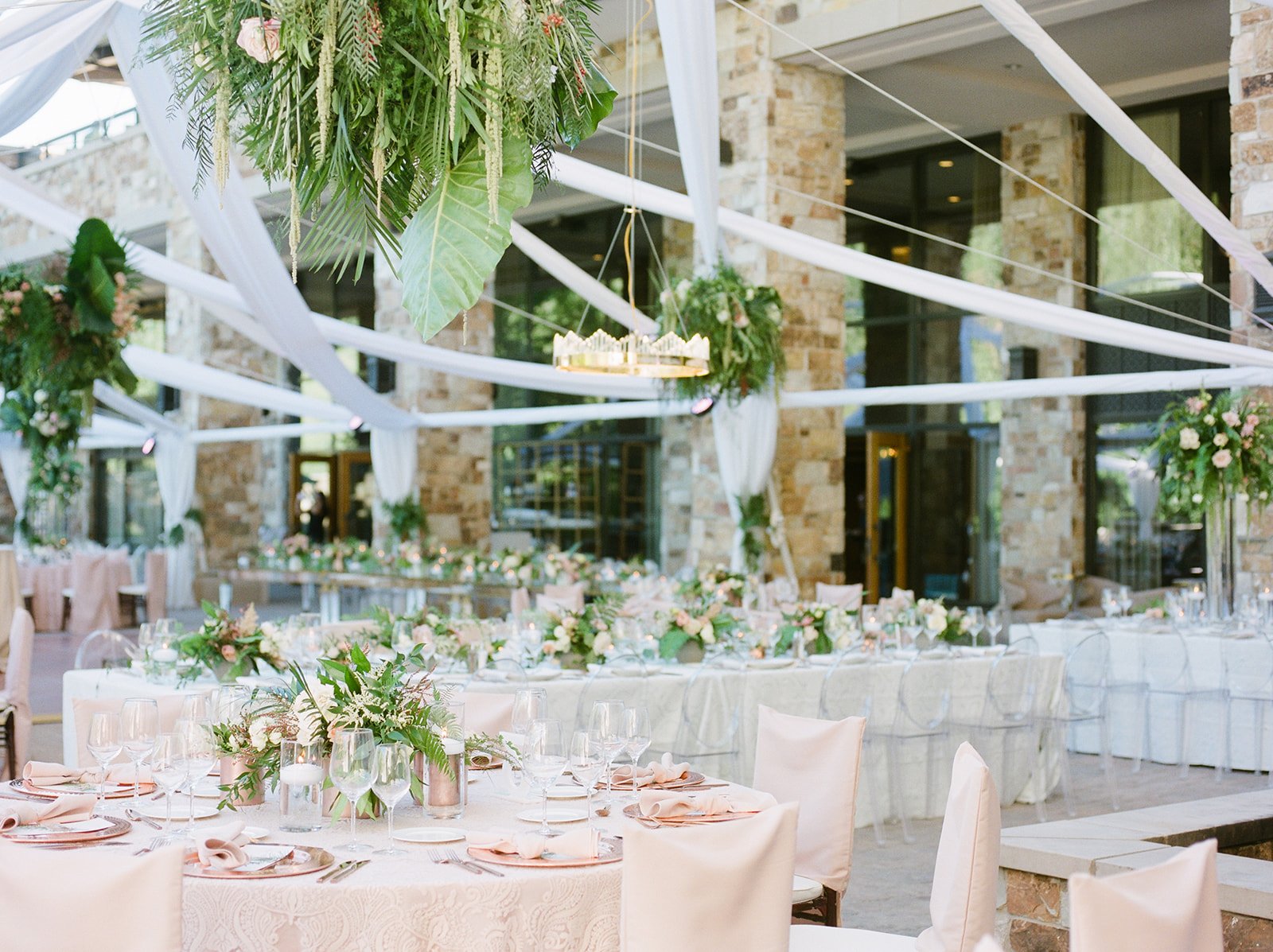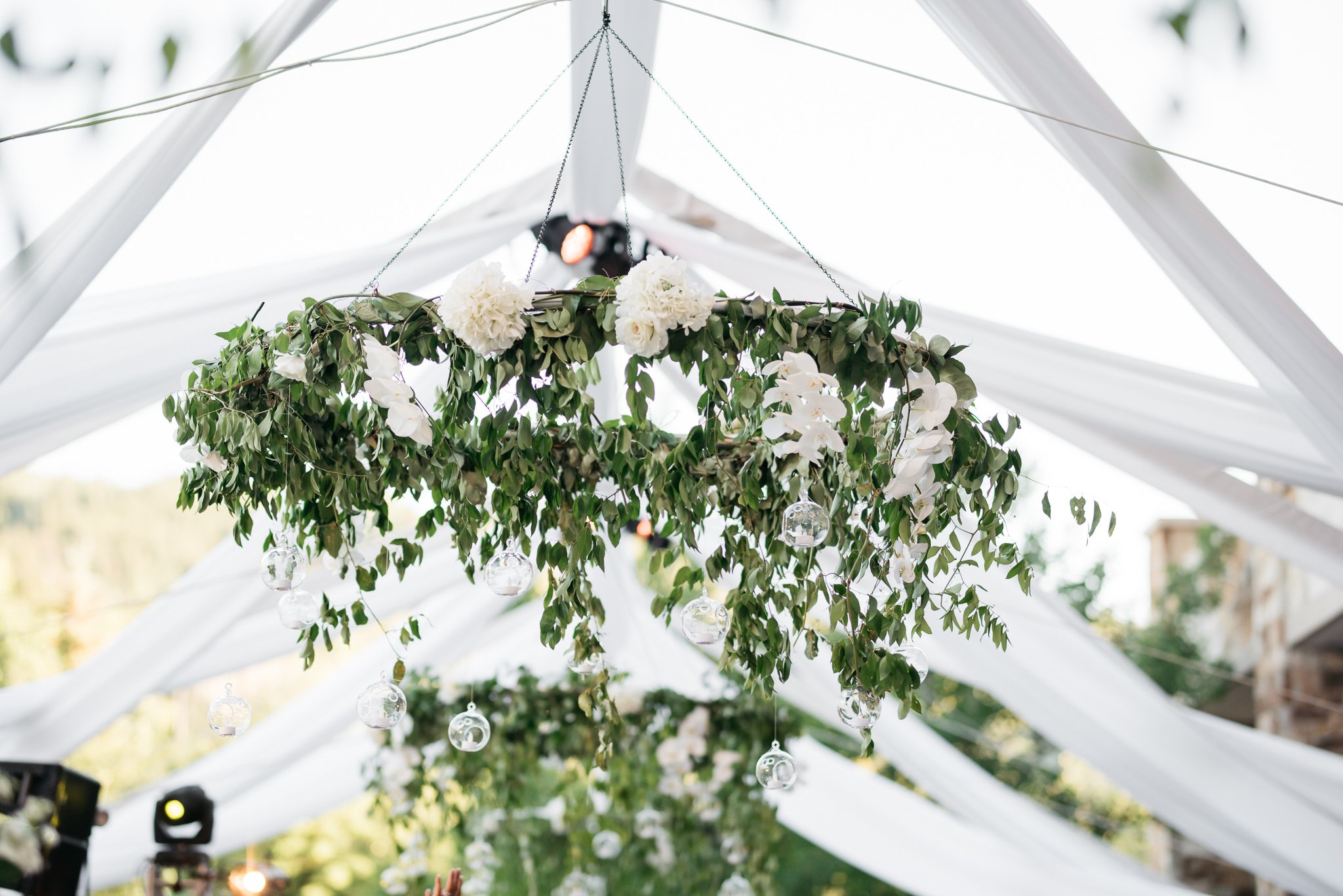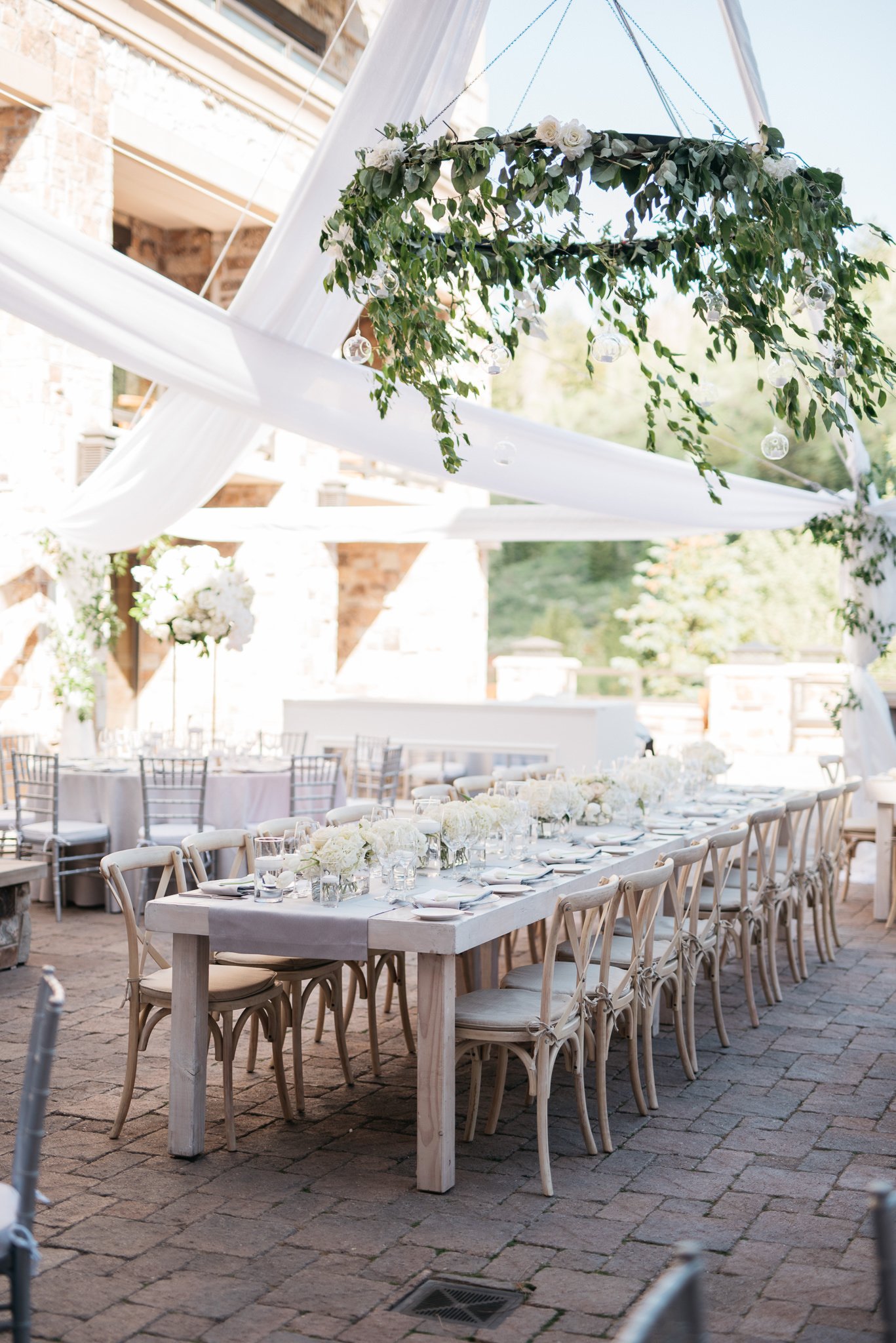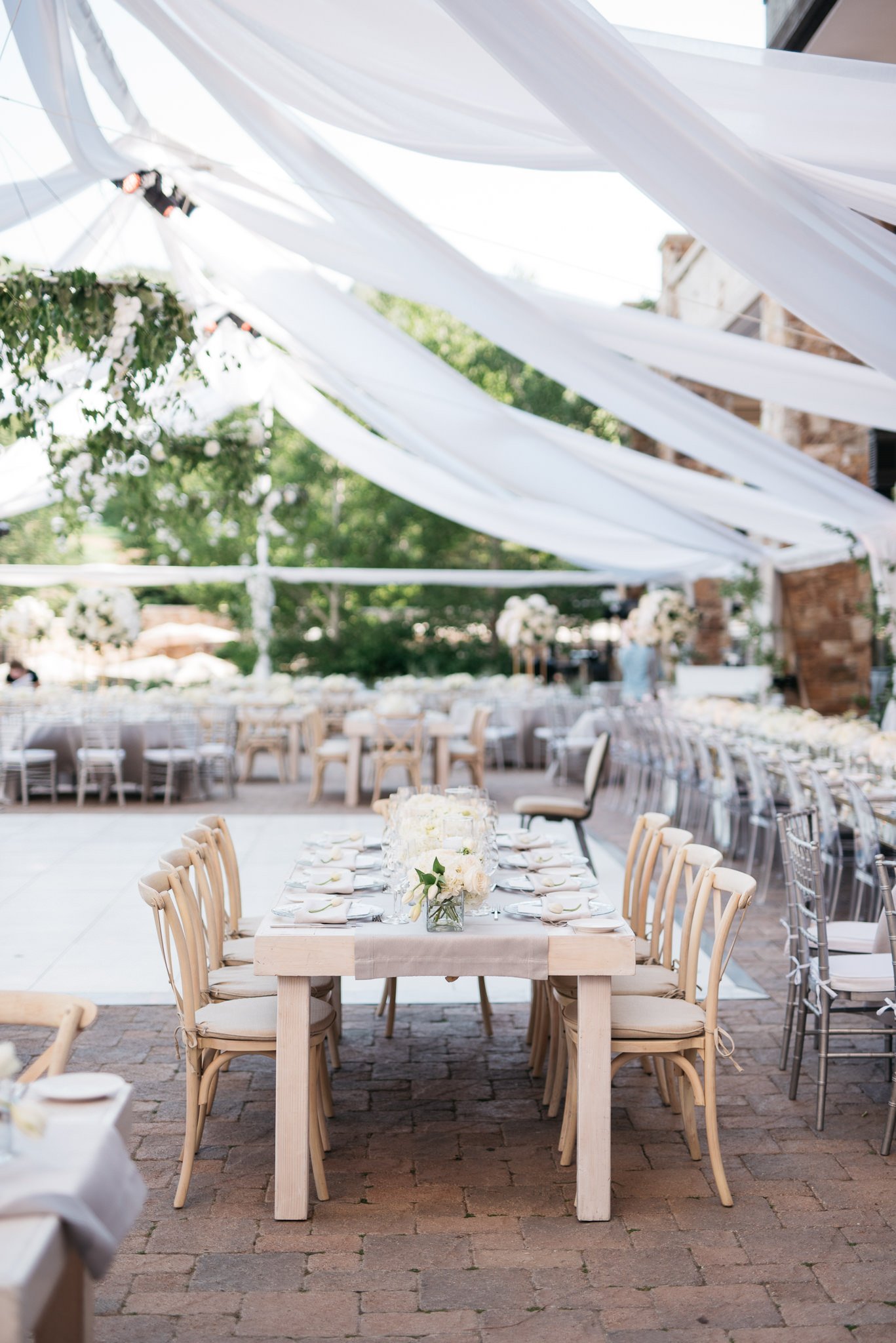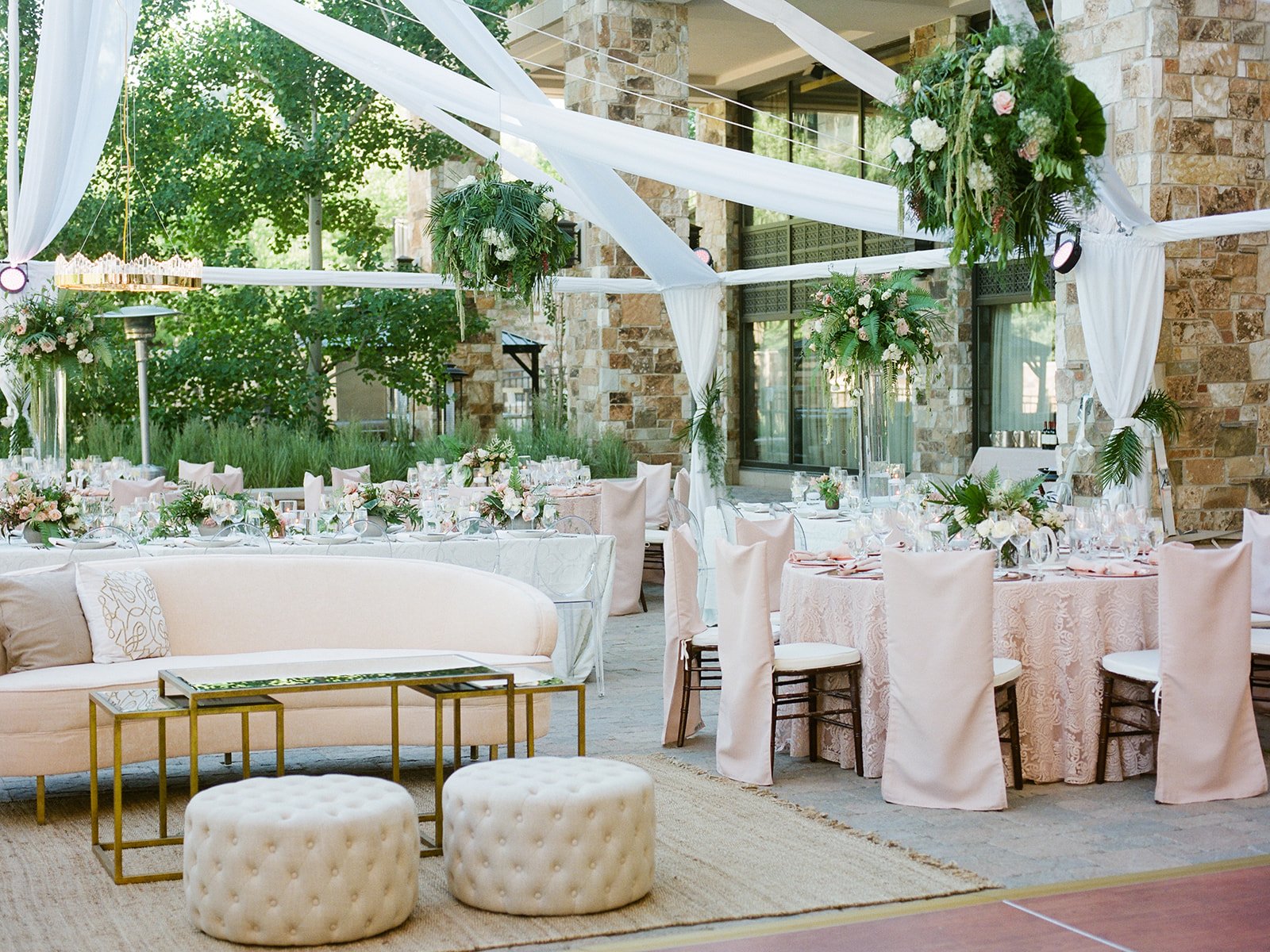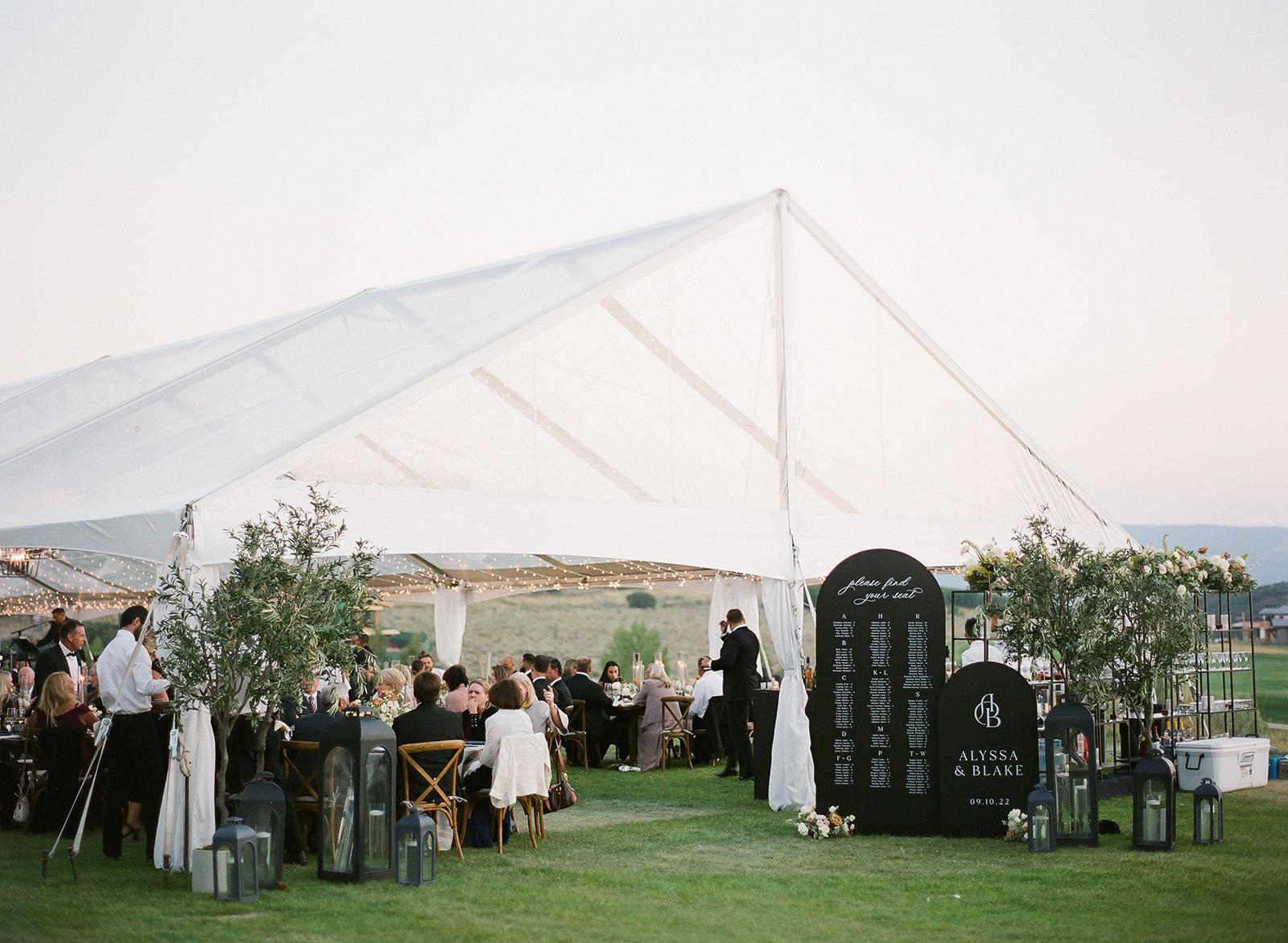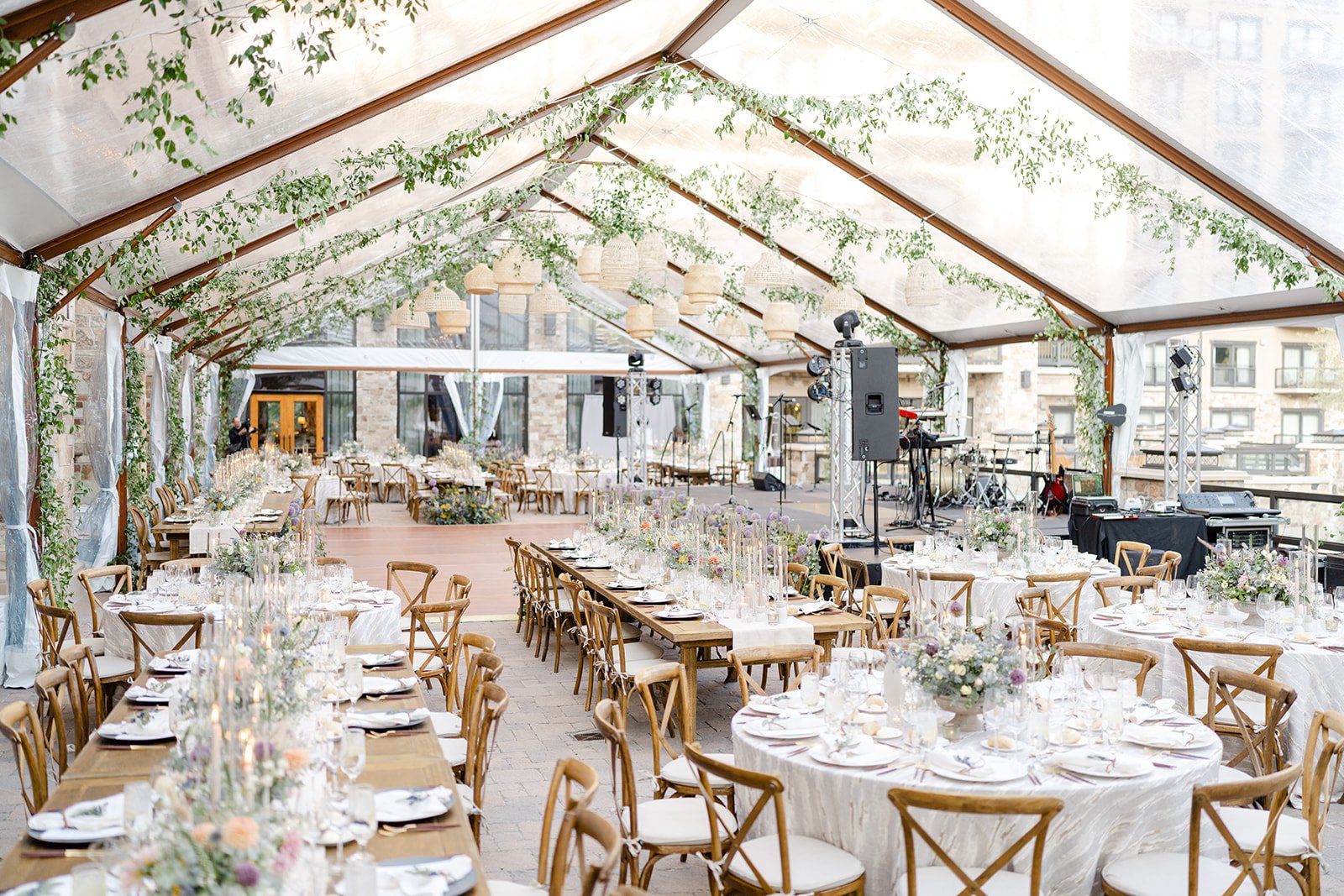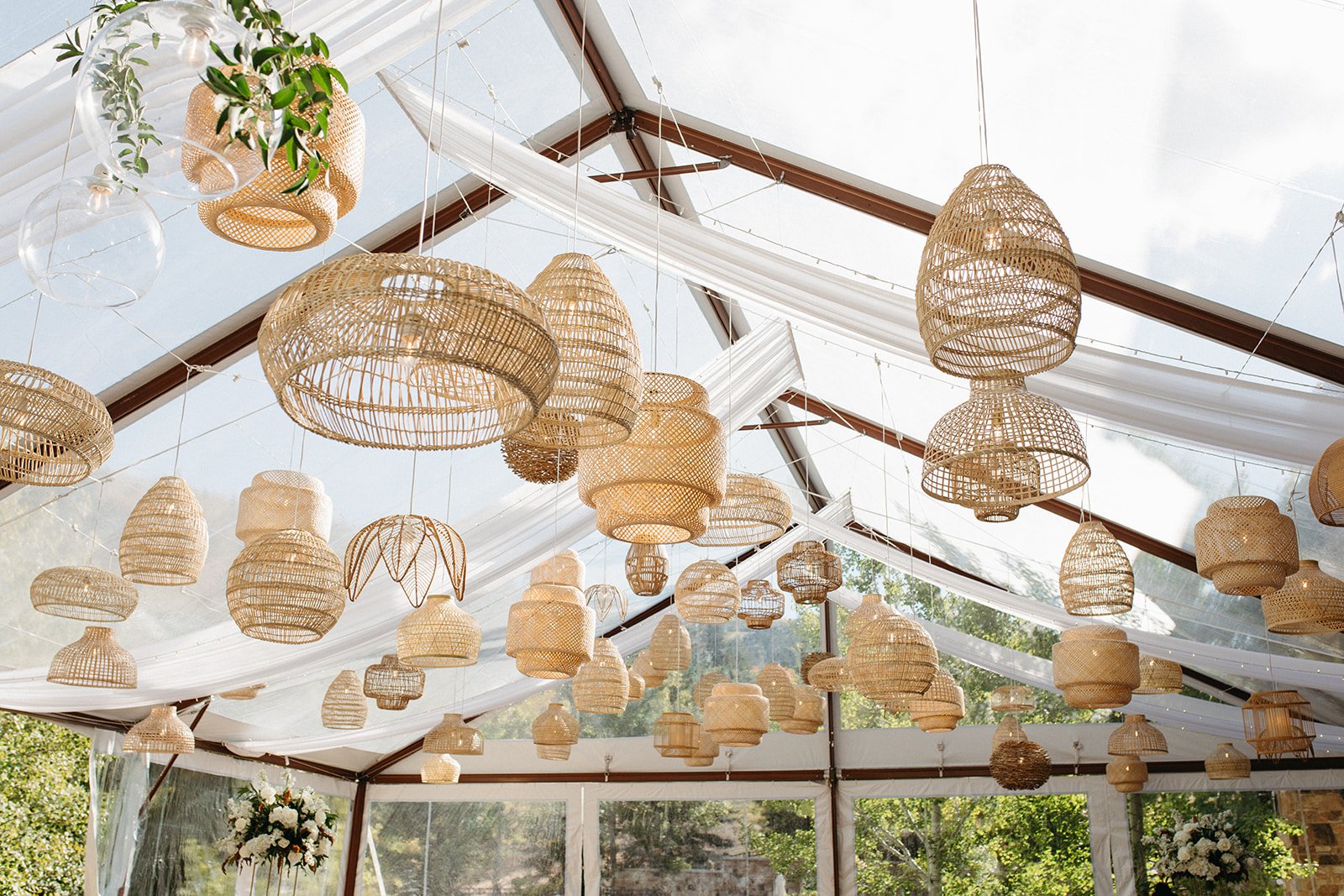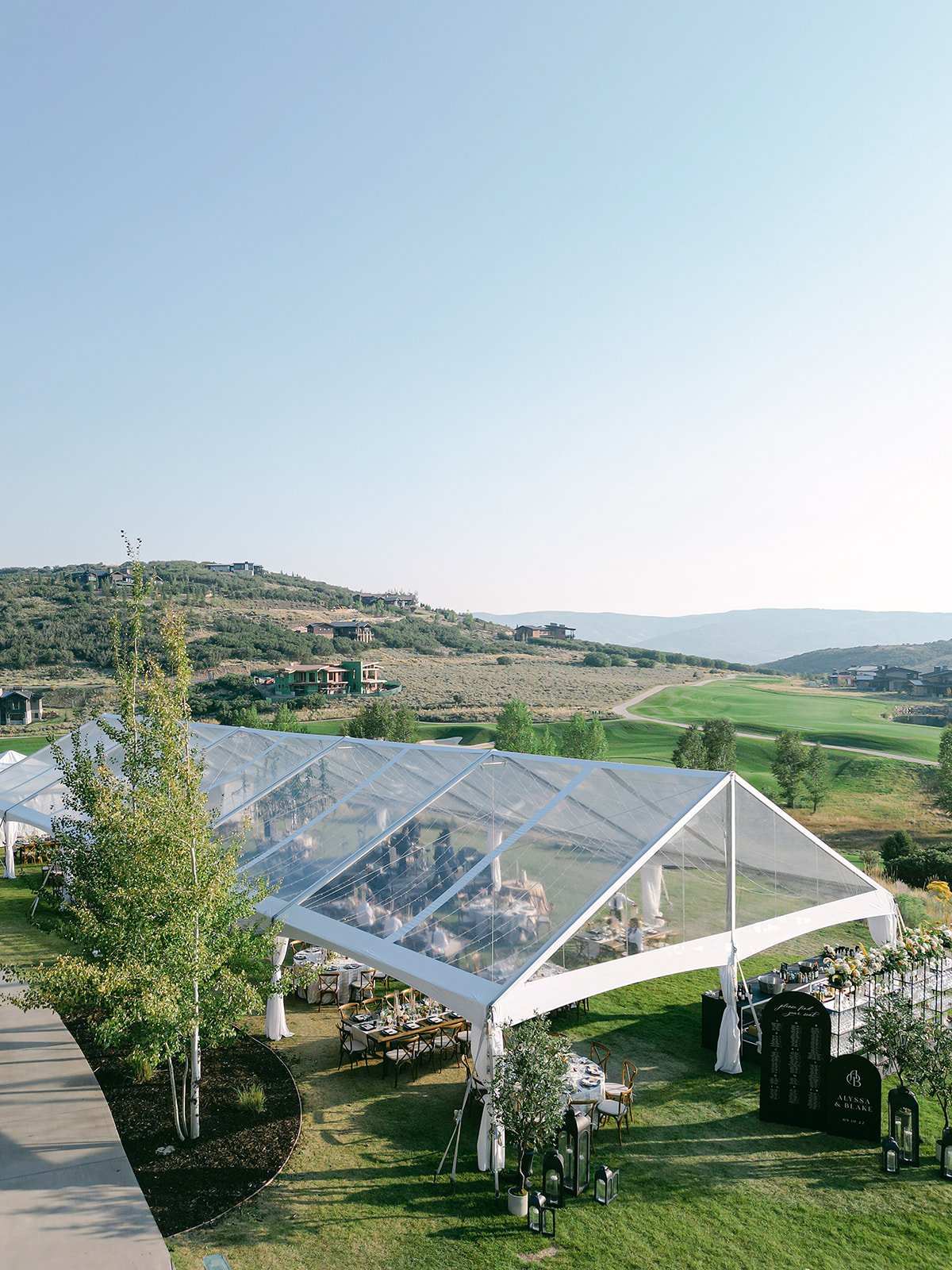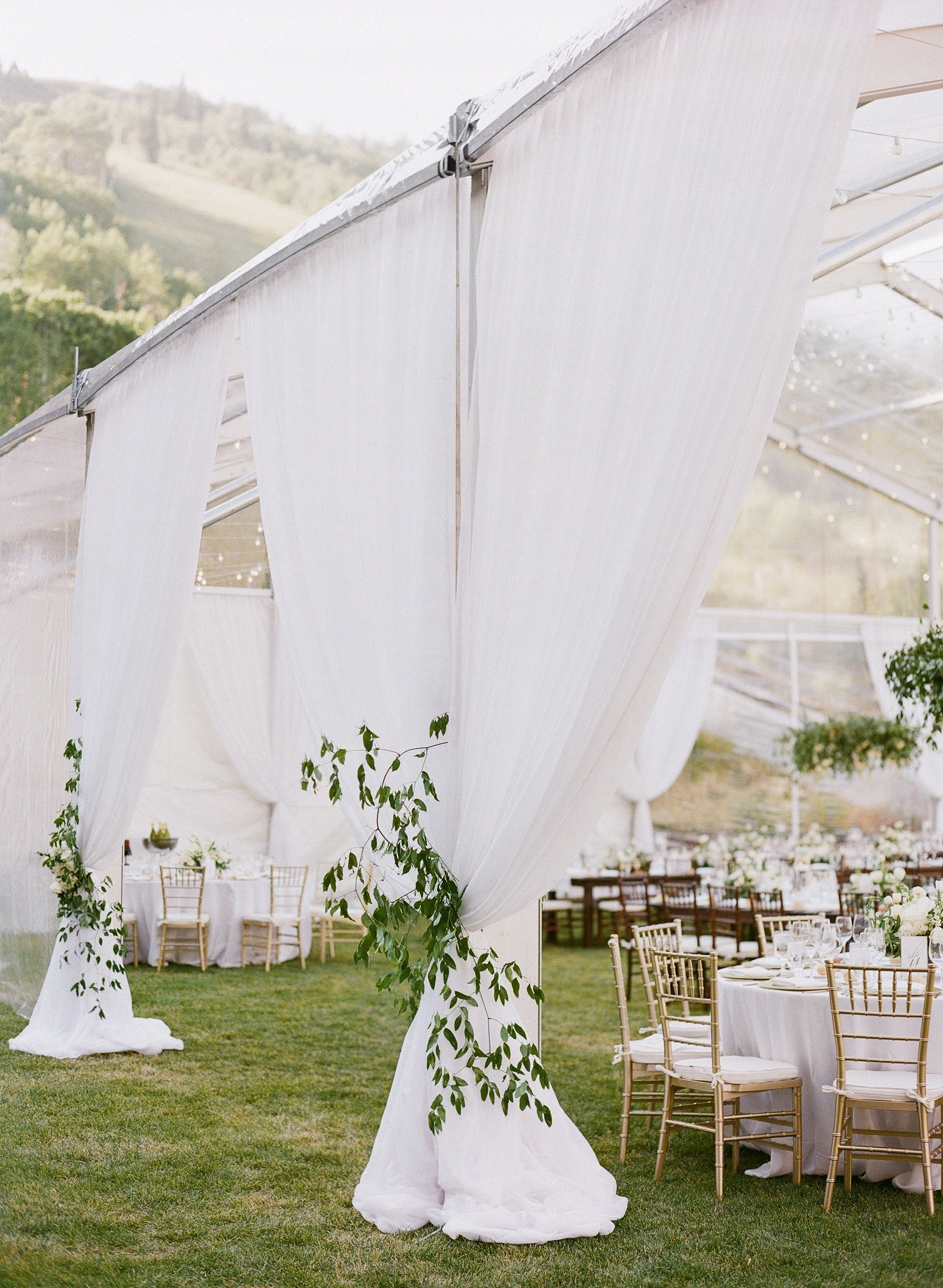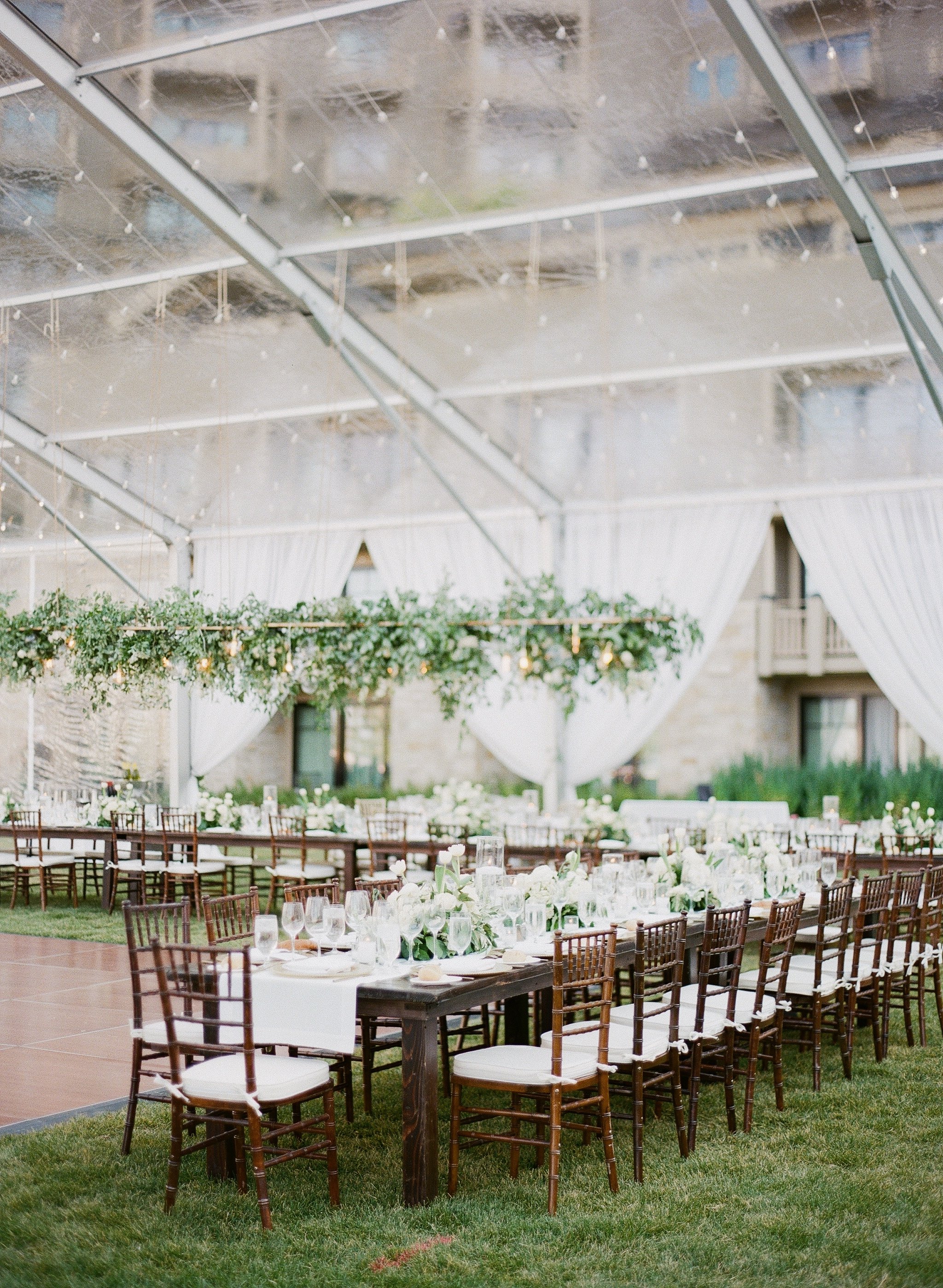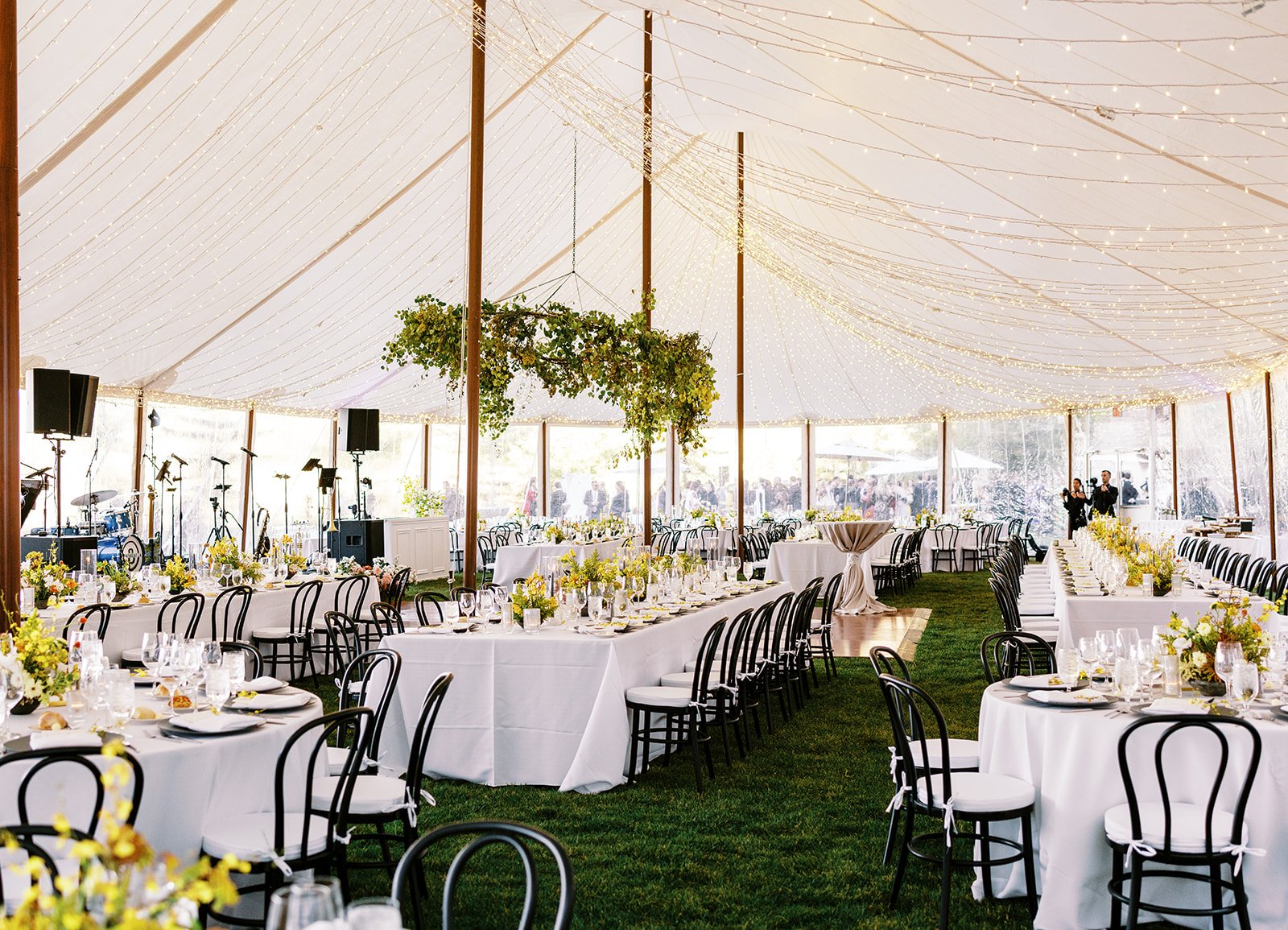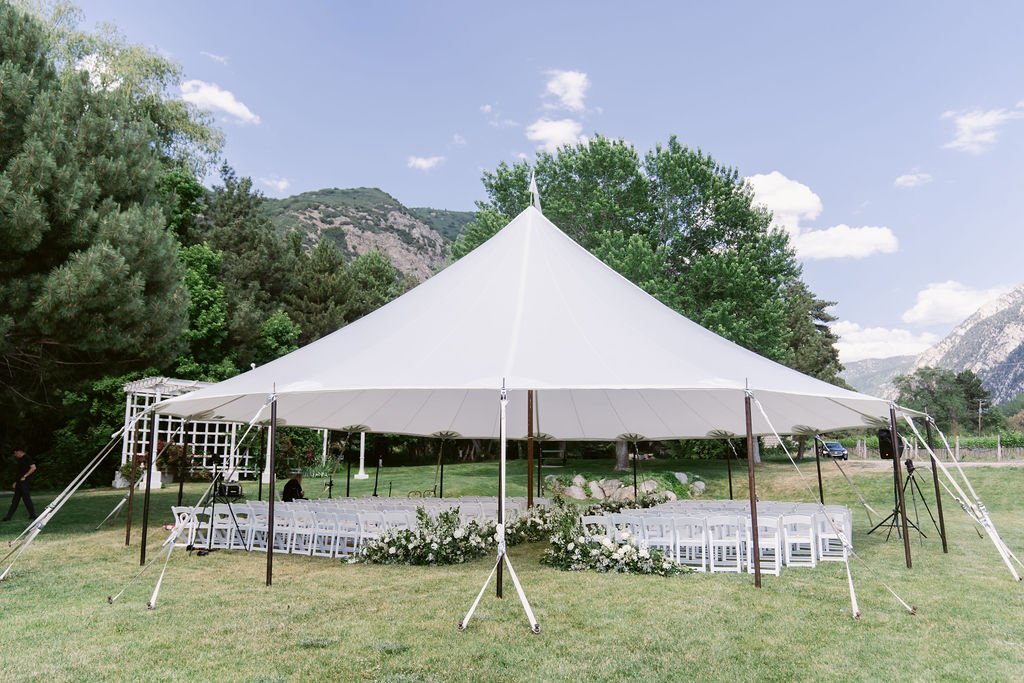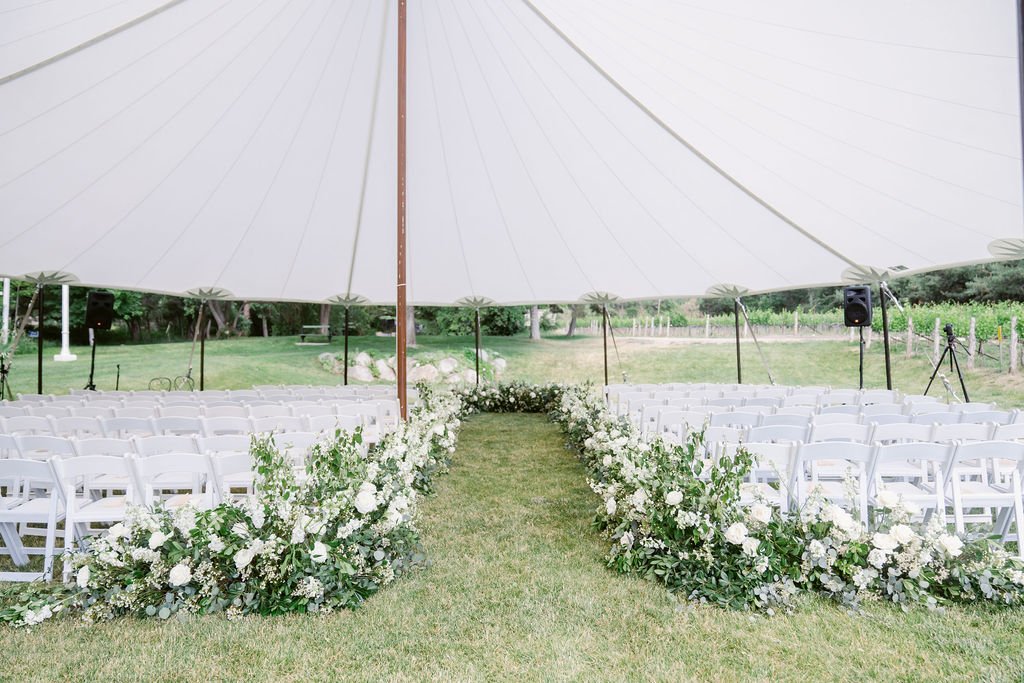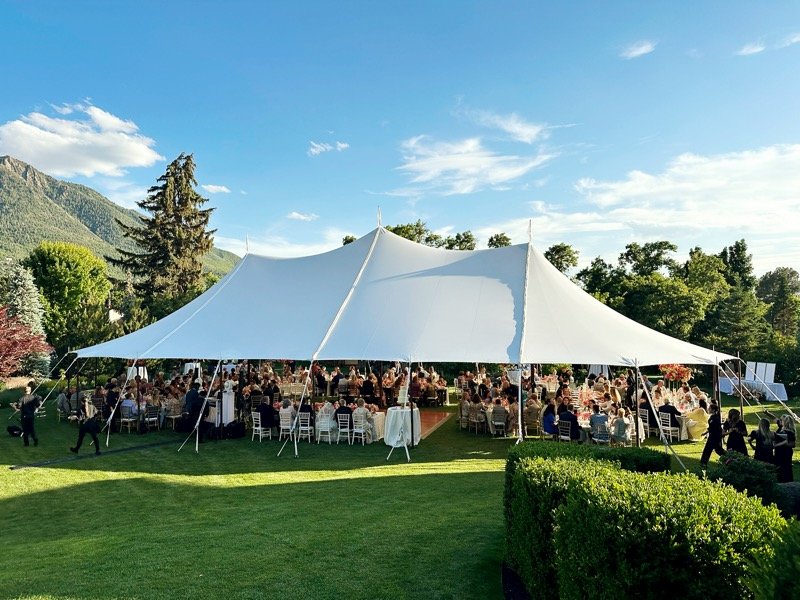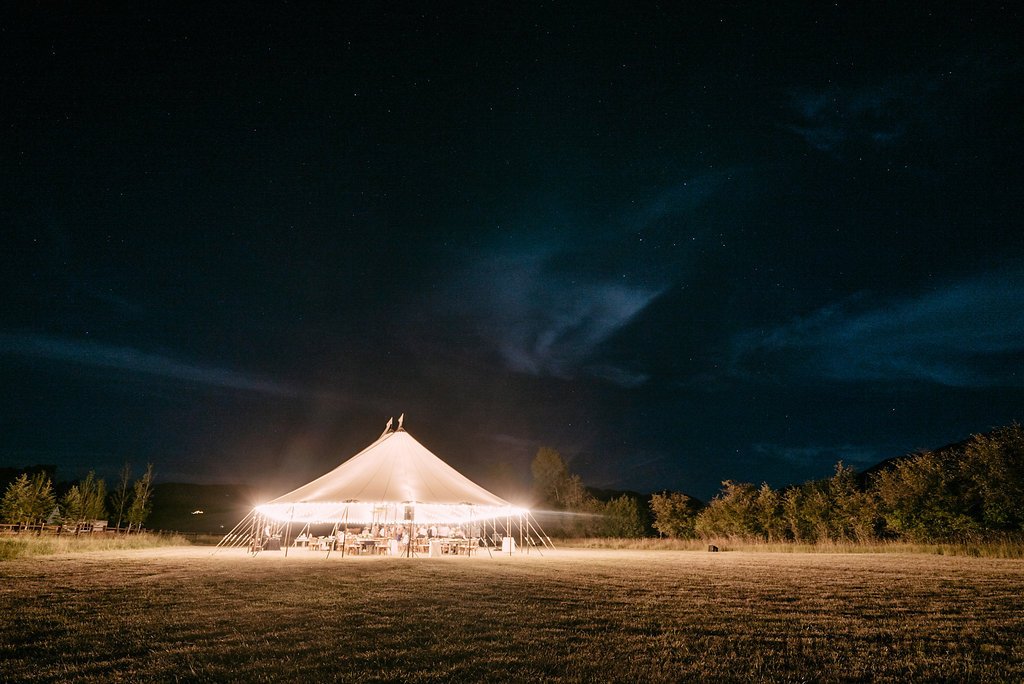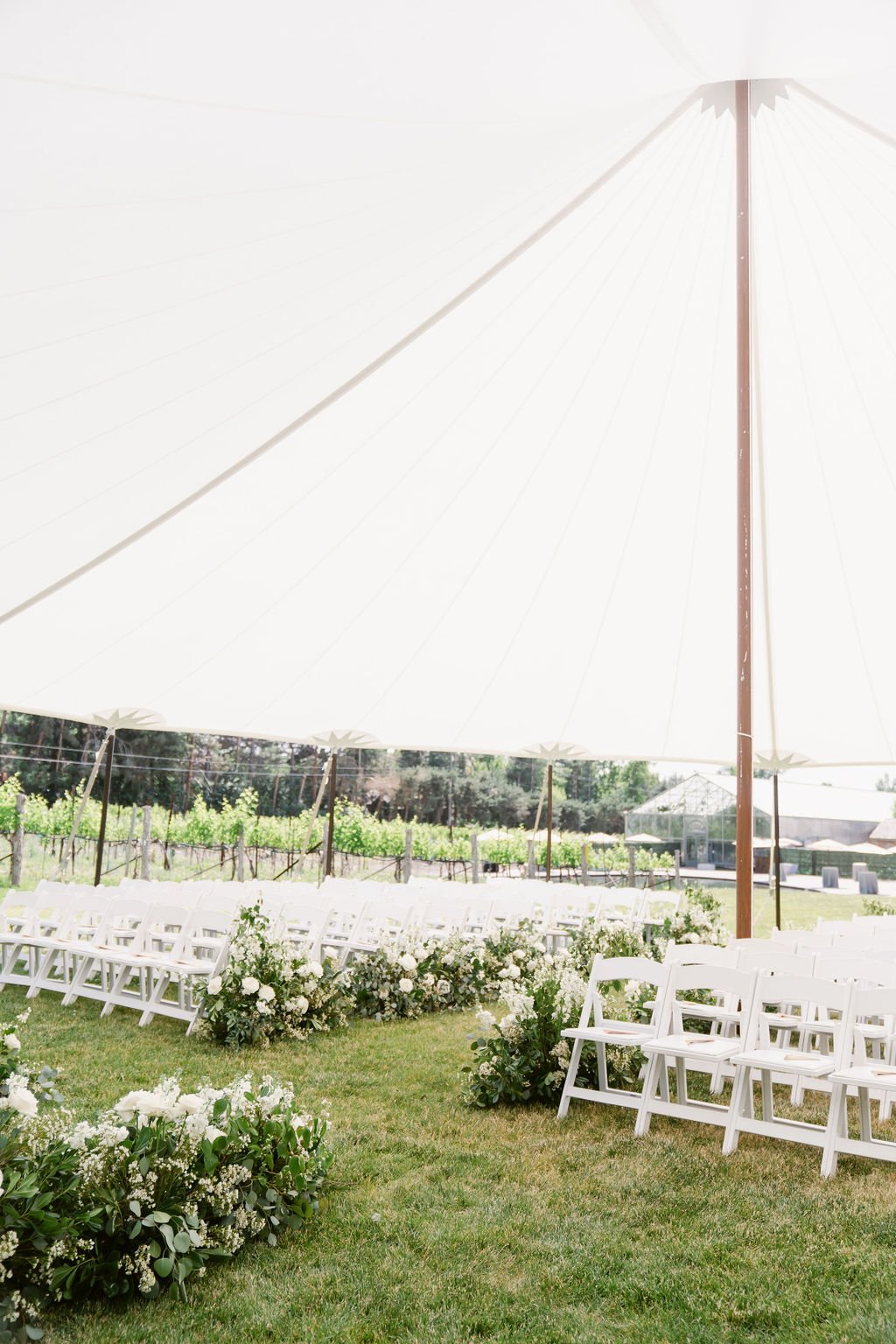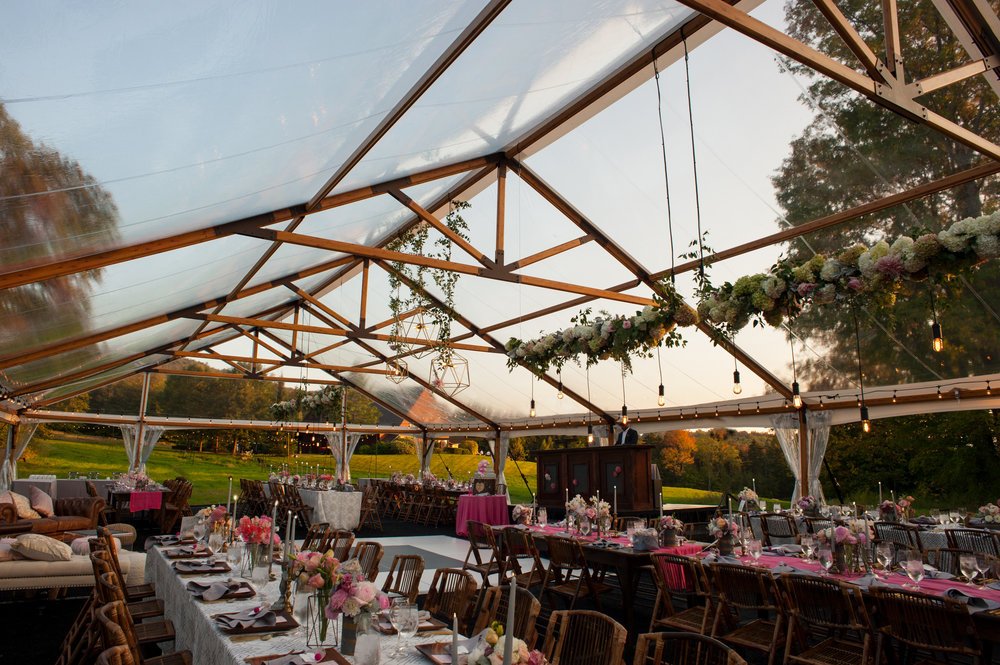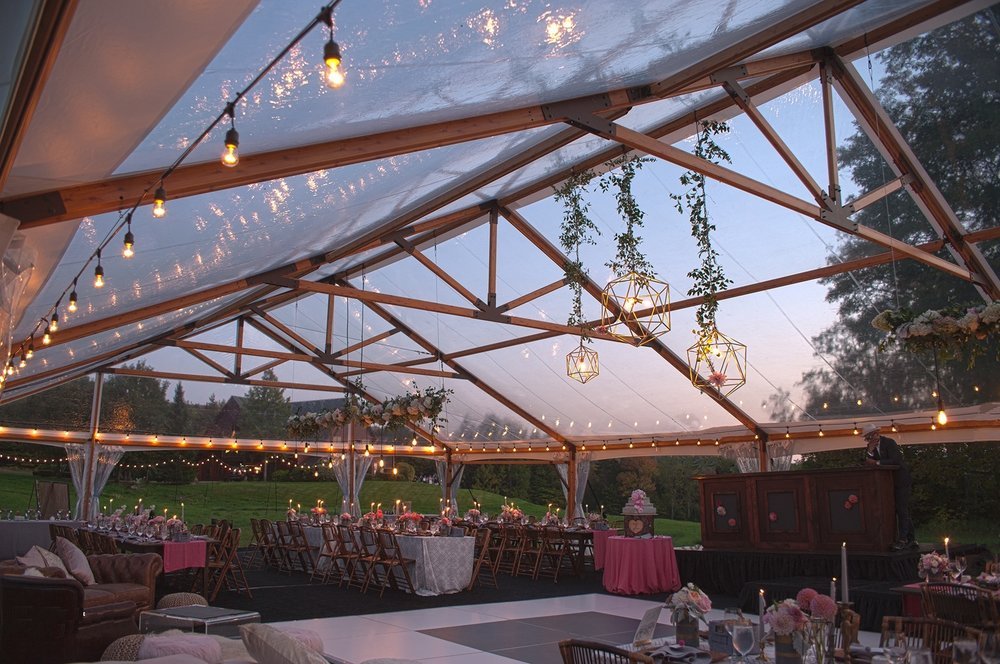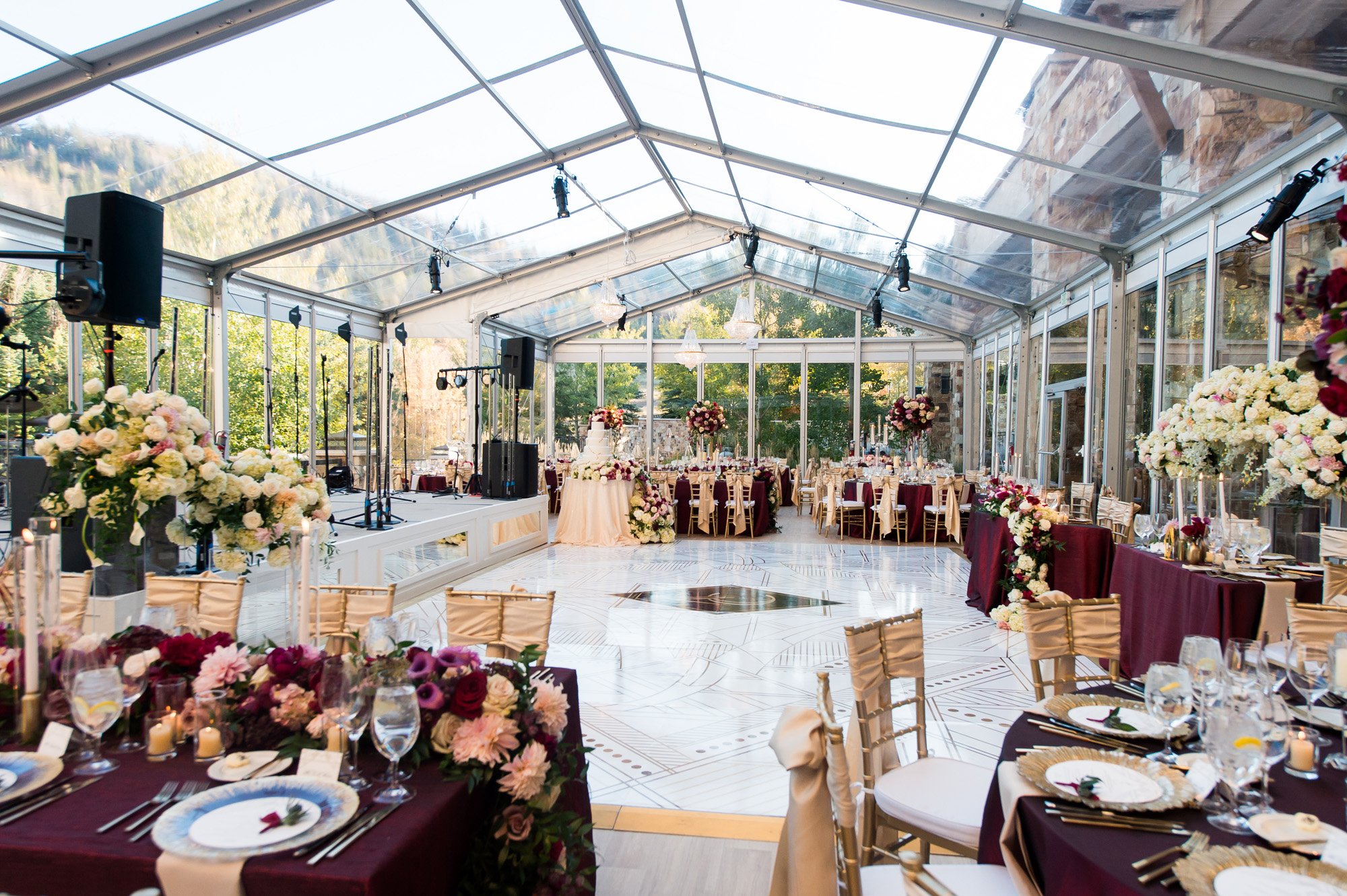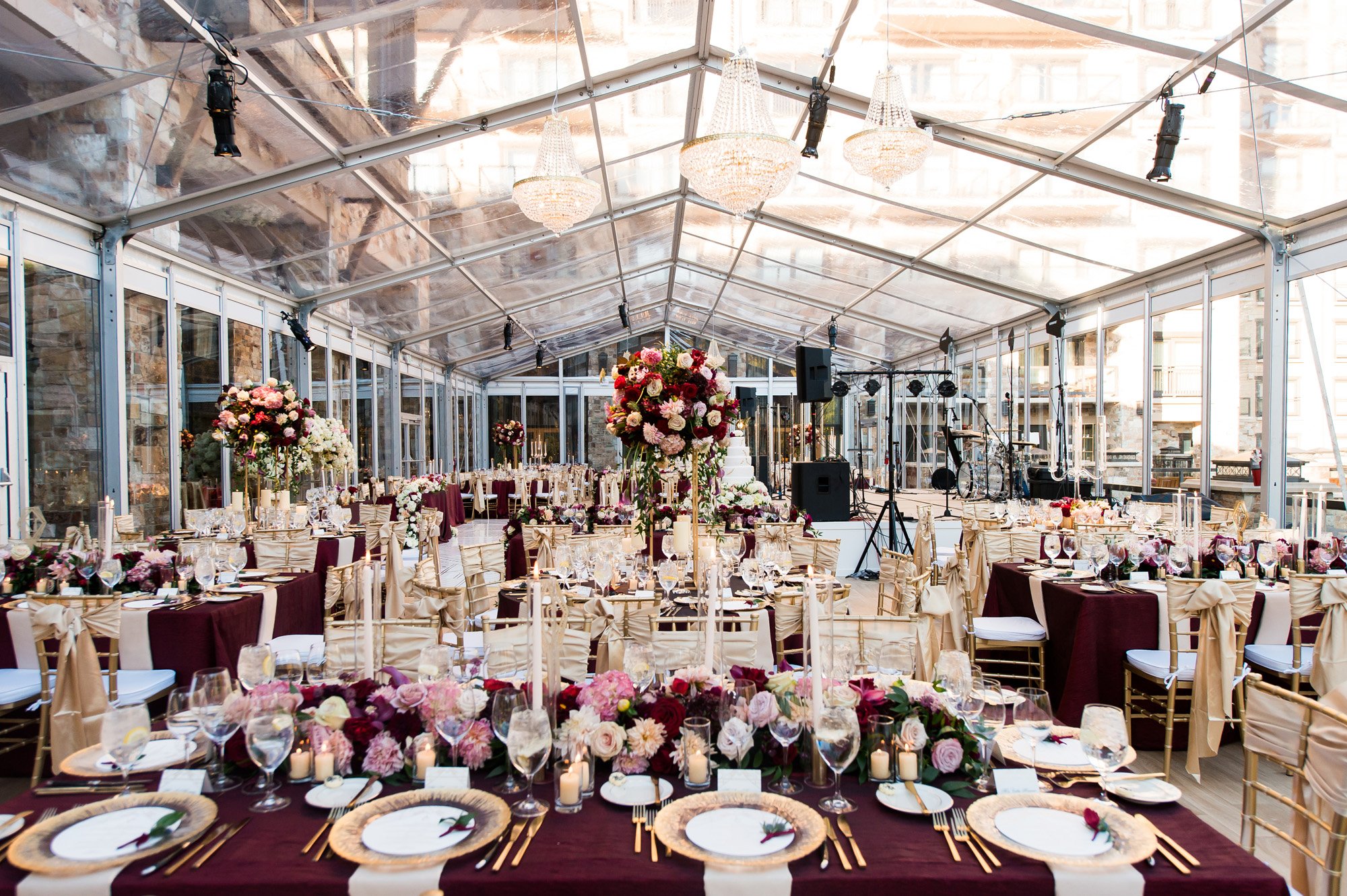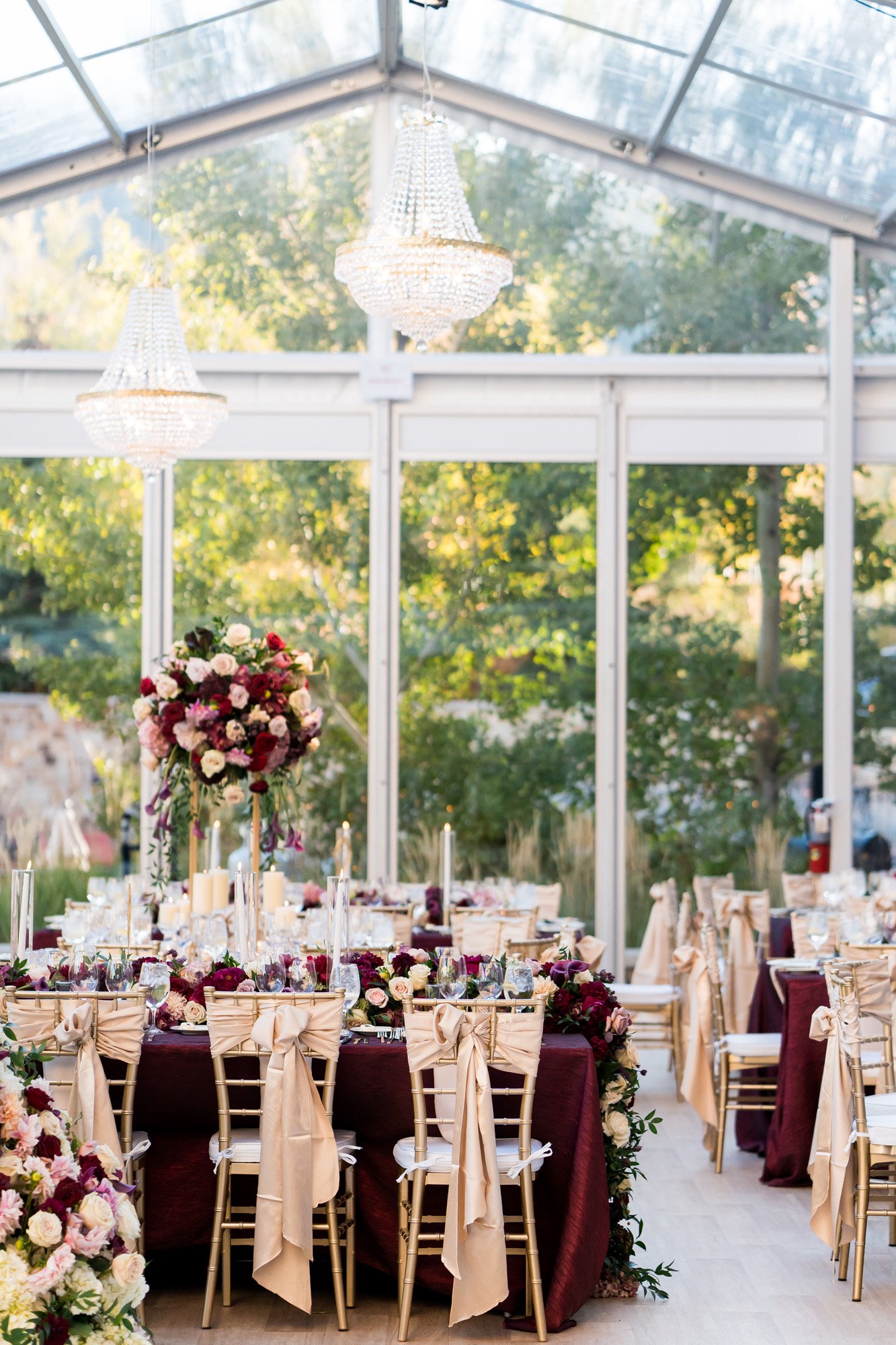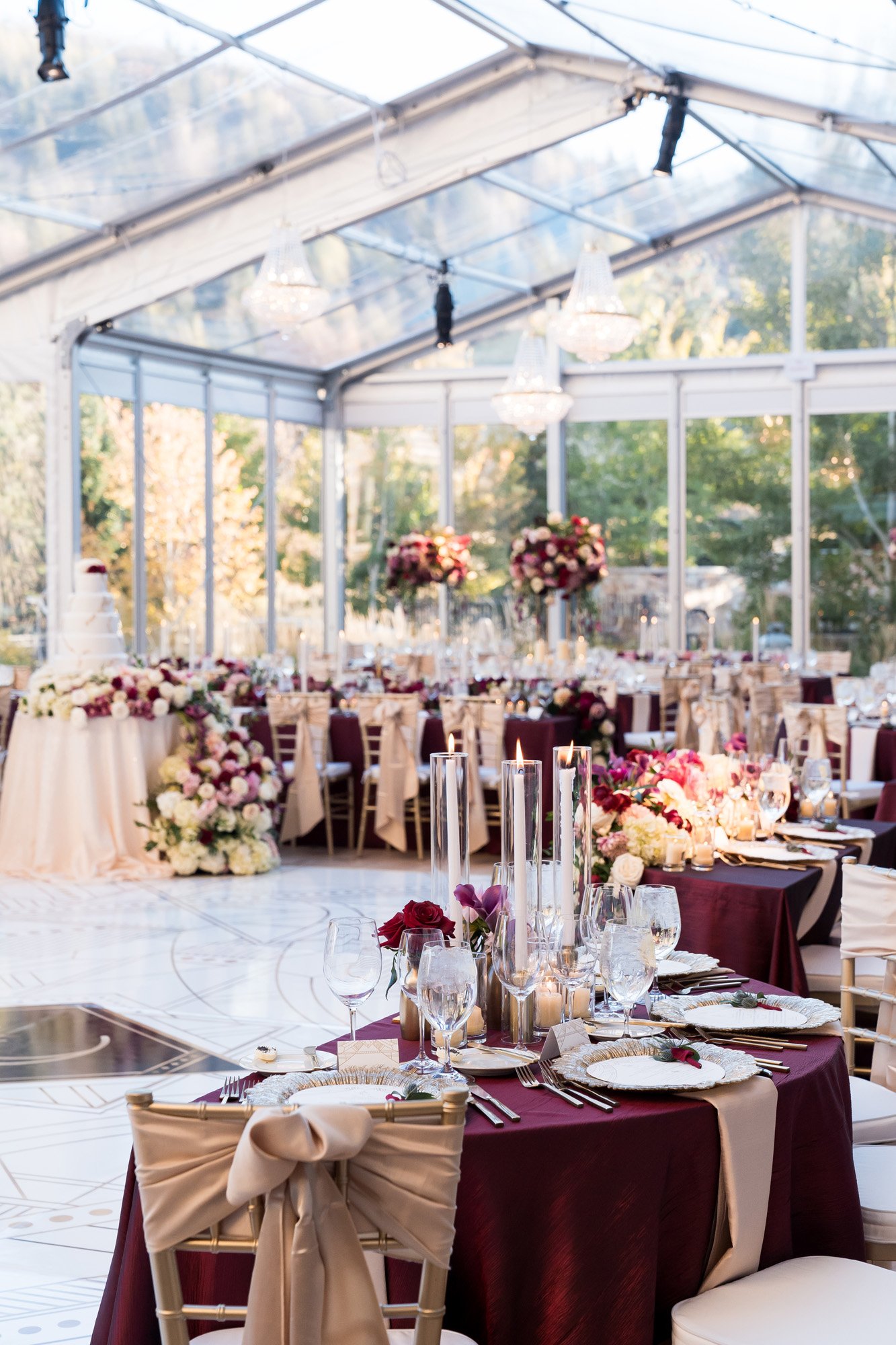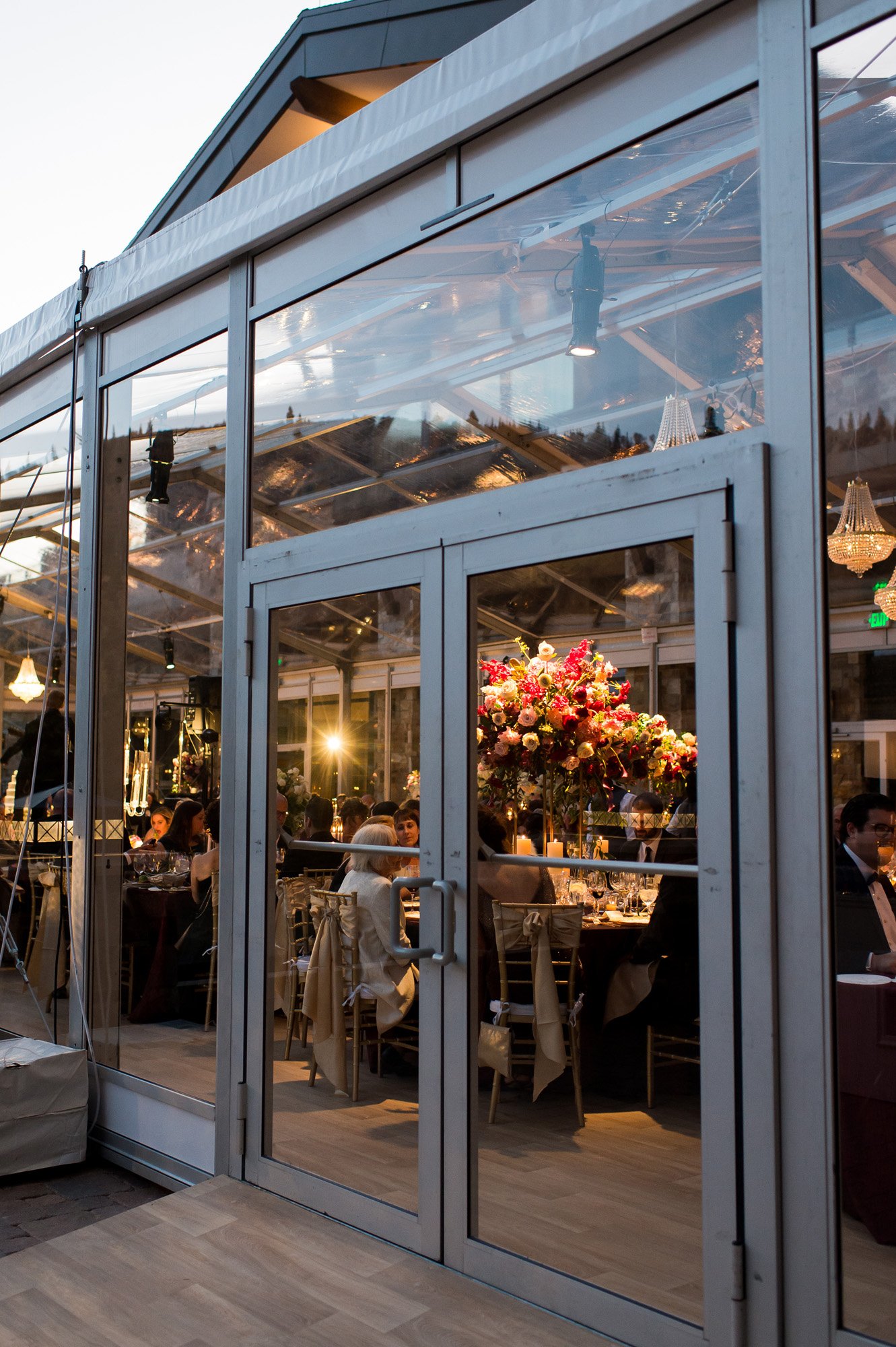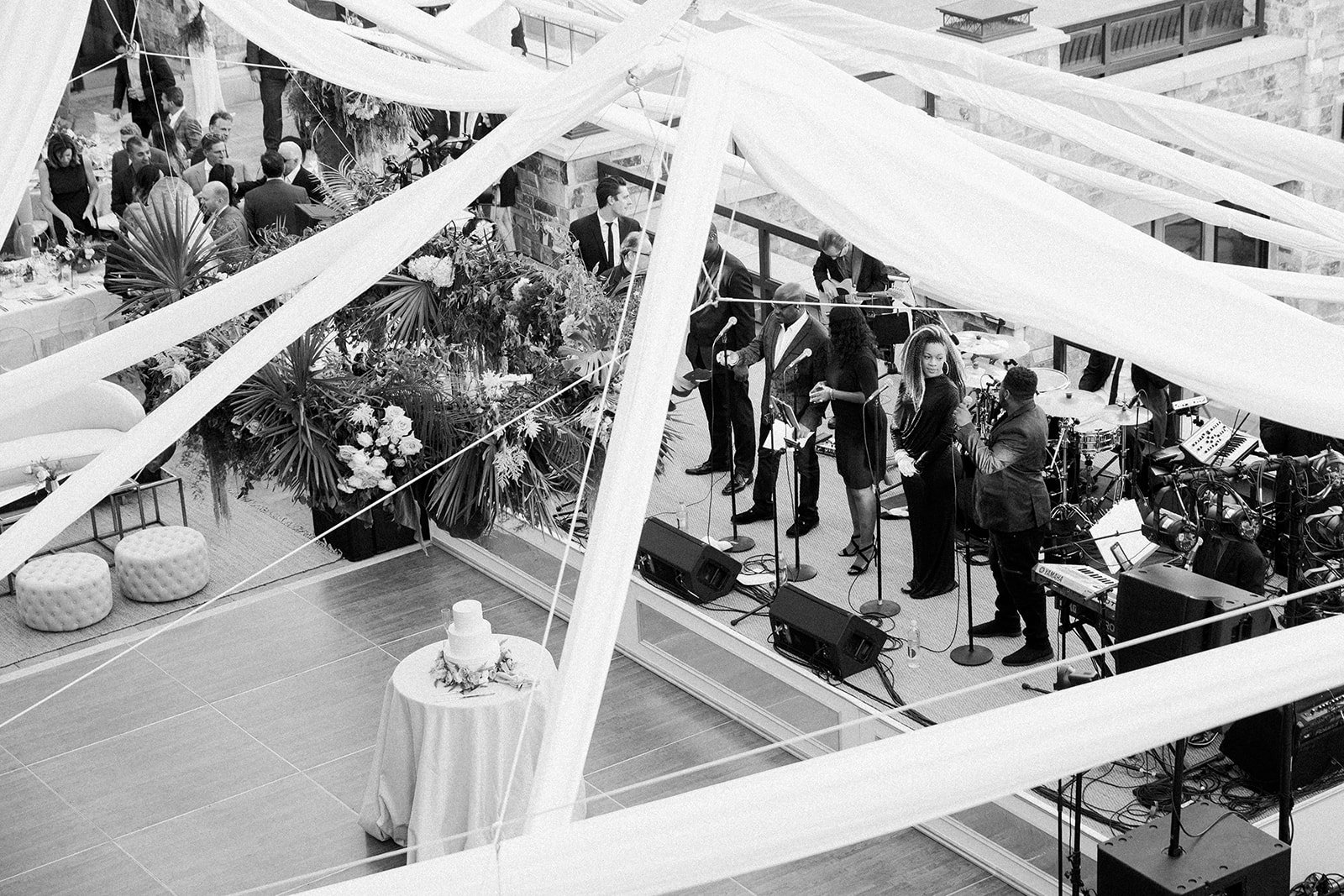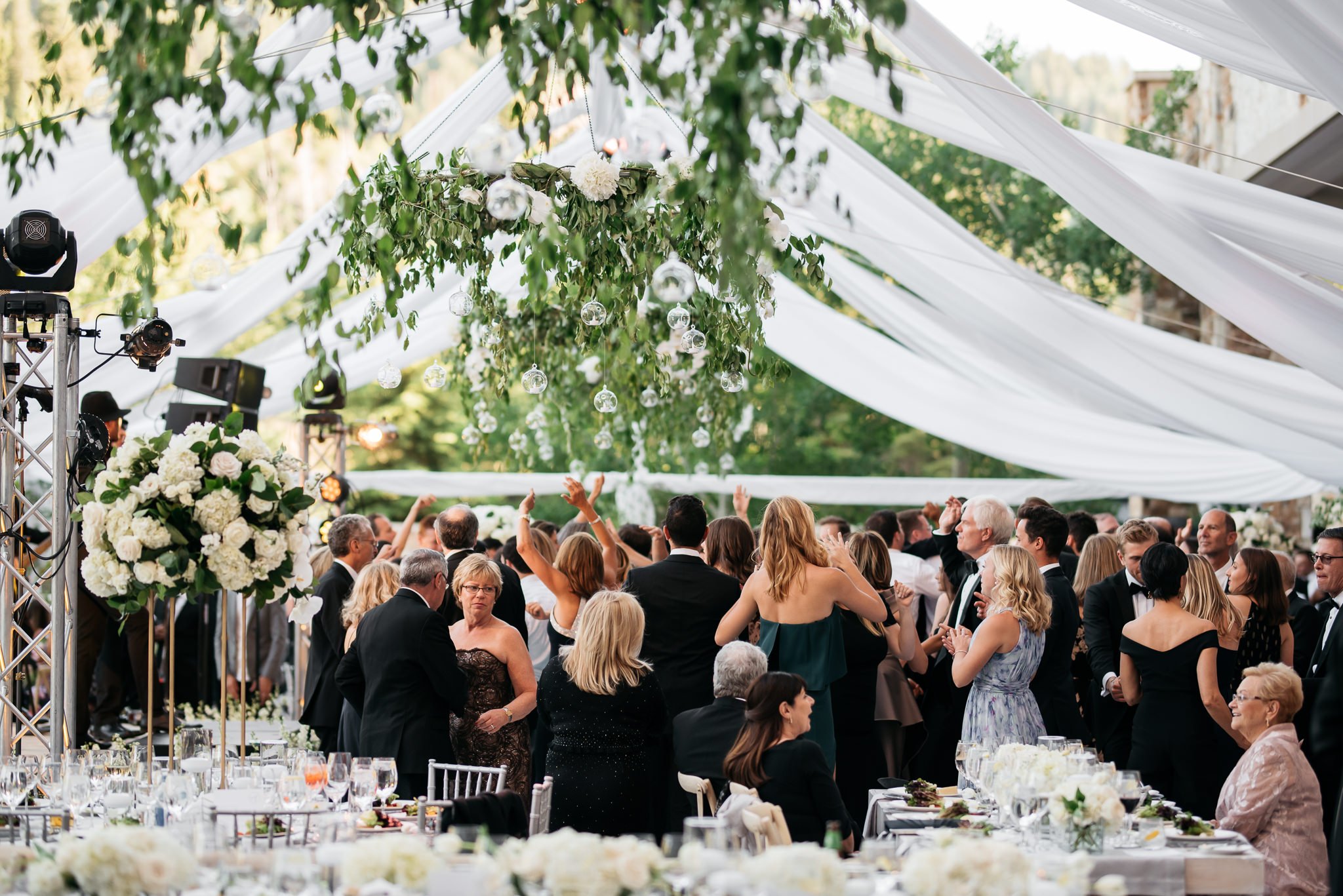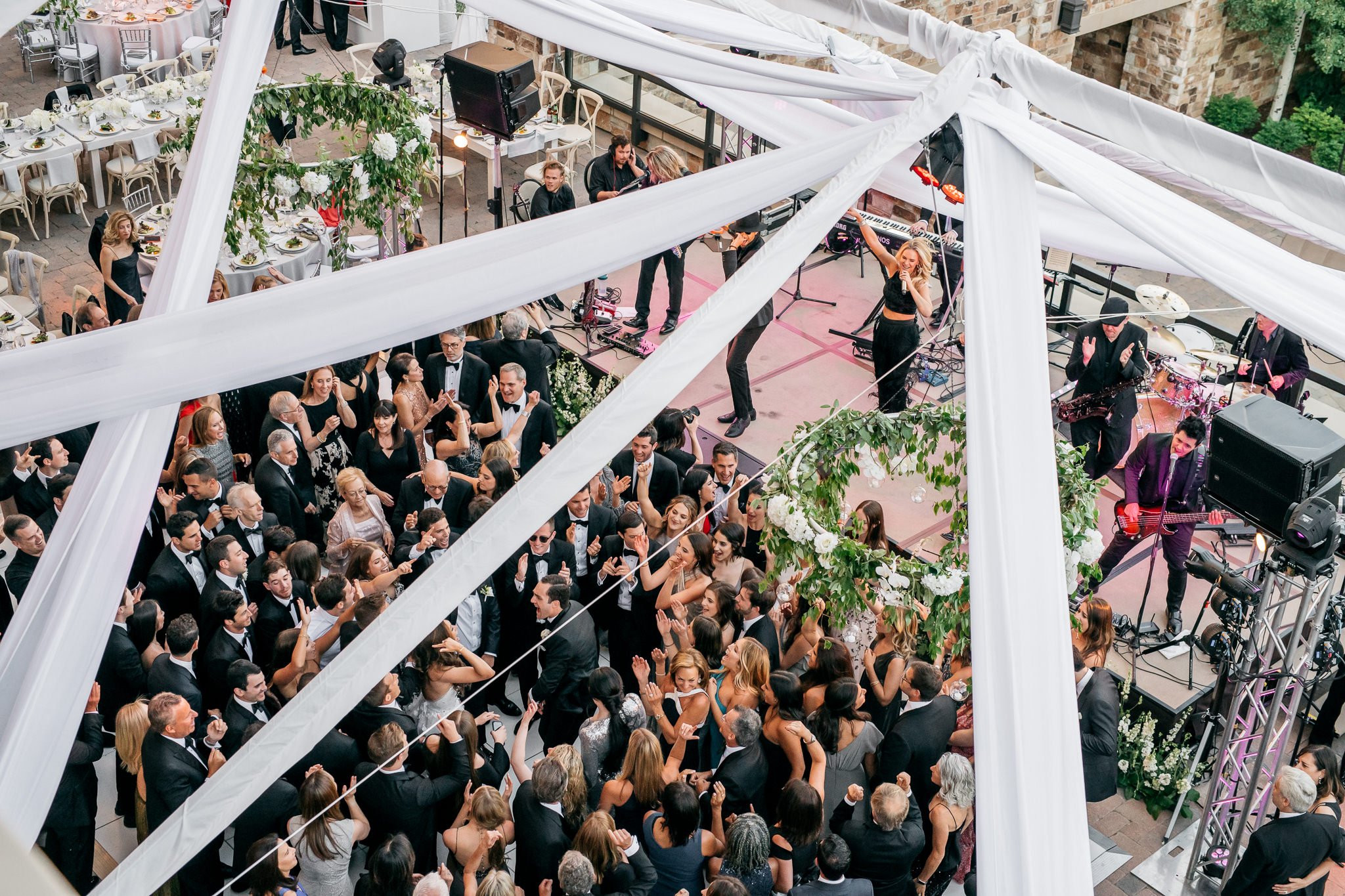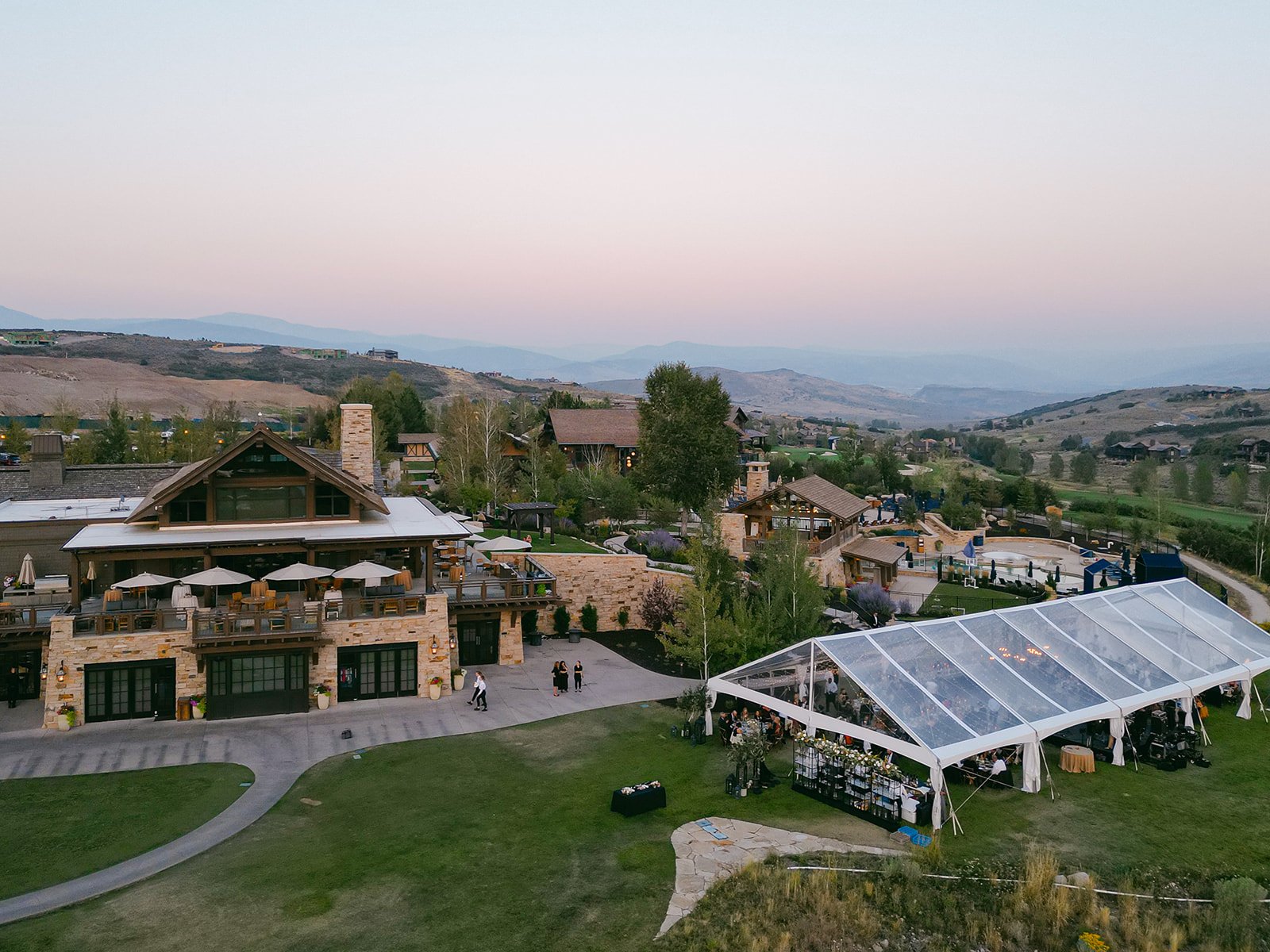Wedding Tents
How to Choose The Right Tent for Your Wedding or Event
There are many factors to consider when it comes to booking a tent for your wedding or event such as style, sizing, location, and price. The main reason people book tents is because tents provide peace of mind as they serve as a great weather backup plan allowing you to focus on other, more important details about your big day. But how should you go about selecting which tent is right for your event?
The pros and cons of utilizing a tent/canopy at your event:
Understanding the difference between a “canopy” and a “tent” may help you in your decision making process:
Design Freedom- Utilizing a canopy/tent for your event provides you with a neutral space to fully customize the look of your event. With a tent, you have the freedom to create your vision from scratch because you aren’t competing with hotel carpet, wallpaper, pre-existing lighting and other permanent elements of an indoor venue.
Peace of Mind- The use of a tent/canopy provides peace of mind for outdoor elements because they ARE the weather backup plan (and we all know how important Plan B is when it comes to outdoor events. While weather-related decisions still have to be made with a structure in place (will you have walls, heat, etc?) you can still rest-assured that the comfort of your guests will not be compromised by celebrating outside. Snow however may present some additional obstacles and it’s important to consider at what point the event should be moved indoors as the fabrics used canopies/tents are not meant to hold heavy amounts of snow and many are not conducive to super cold temperatures (vinyl can freeze and crack or tear in extreme cold leaving the structure permanently damaged).
What style of tent/canopy should you choose?
Victoria Knackstedt, event sales manager at Diamond Rental, shares her knowledge on the true differences between a tent and canopy:
“A tent has center poles inside the structure that create high peaks, and staking into the ground is required to provide tension to hold the poles in place. Canopies have no poles inside, and instead rely on the exterior framing to hold up the tops. Canopies can be secured with staking or weighting.”
When it comes to luxury wedding tents, there are four main options MLE suggests considering:
“NAKED” CANOPY (This look includes the frame and draping only - no canopy top)
VINYL CANOPY (available in clear or white)
SAILCLOTH TENT (also referred to as a “tidewater” and made of sailcloth material, includes peaks and little flags, and is extremely popular on the east coast)
TIMBERTRAC (newest design feature that allows for easier installation with less wear and tear on fabrics used)
When selecting which structure is right for your event, it’s important to consider several factors including:
Sizing- structures come in different sizes and you’ll need to select one that provides the square footage necessary to accommodate the size of your event.
Pricing- it’s important to determine which structure works best with your budget.
Location- not all structures work in all spaces. Some structures require staking into softer surfaces (such as grass) and can’t be used on solid surfaces such as cement.
Style & Design- different structures offer specific looks and styles and you’ll want to select the style that best compliments the design of your event. Some structures accommodate ceiling installations such as lighting, draping and hanging floral whereas others do not. Consider these design elements before making your final selection.
We understand the tent/canopy is a very big decision that many clients will have to make at some point during the event planning process. Over the years, MLE has had the opportunity to use each of the existing tent/canopy structures at a variety of our events. As such, we put together the following in-depth overview with imagery to aid in your tent decision making process.
“Naked” Canopy
If draping and/or lighting is a style that you find yourself drawn to, but you’re not interested in having an actual canopy top, you can elect to have a “naked” canopy.
Structure- With a naked canopy, the canopy is technically missing from the frame because it literally isn’t isn’t attached, leaving the frame “naked”. This style still includes all the attachment points required for lighting/draping and hanging floral details above your event space. This design choice provides a unique, modern, and elegant look.
Protection- Because the canopy top has been eliminated, a naked canopy does not offer any kind of protection from the elements such as wind, rain and the hot sun. But that doesn’t mean you can’t have a canopy on hold as a weather backup plan. Tent expert, Miranda Boss from All Out Event Rental says:
“Because a naked tent doesn’t provide protection from the weather, we always include either a white or clear canopy top on the rental invoice as a weather back up plan.”
Available Sizes- Sizing for canopies will come in a range from 20x20 to as large as a 100x40, providing coverage for anywhere between 40-300+ guests. Always check with your local rental companies to see what sizes they offer.
Pros/Cons- Creates an open concept for true outdoor feel, however provides no protection from the weather. Provides attachment points required to have lighting/draping/hanging floral in an outdoor space without existing attachment points for decor.
Vinyl Canopy
This is the most popular structure due to its flexibility in style and sizes.
Structure- Vinyl canopies are metal-framed structures with a vinyl fabric top. The metal frame resembles the shape of a rectangular house, with the ceiling being the same height all the way across the roof of the tent. These frames can be staked into the ground if you are placing the tent on a grass surface, or they can use weights (water ballasts) if you need to place the tent on a hard surface such as the concrete of a patio or deck space.
Protection- Vinyl canopies provide a great deal of protection against most types of weather and are waterproof. For an added layer of protection, vinyl walls may be added to the sides of the tent as well. Walls are flexible vinyl panels that are attached to the tent frame and can be pulled shut for complete protection, or slit open for air flow. In colder months, vinyl walls are typically applied to tents allowing the structure to be heated.
Available Sizes- Vinyl fabric canopies are one of the most popular options because they are available in a variety of sizes and can accommodate intimate to large gatherings. Sizing ranges from 20x20 to as large as a 100x40, providing coverage for anywhere between 40-300+ guests. Always check with your local rental companies to see what sizes they offer.
Pros/Cons- The biggest benefit of choosing a vinyl canopy is the flexibility in sizing allowing you to select a structure that fits the needs of your headcount including a variety of layouts that do not have to be created around stationary objects. Also, because of the style of frame, you have many anchor points to choose from when hanging installations and decor.
Sailcloth
Structure- The sailcloth tent (otherwise referred to as a tidewater), is constructed with poles standing tall in the center of the tent. This tent structure will have peaks where those poles are placed, instead of resembling the perimeter of a rectangular house. While the sailcloth isn’t a clear option like vinyl, the fabric is light enough that it does allow for filtered, natural sunlight to peer through for any daytime events. At nighttime, lighting hung in the tent will glow nicely against this soft fabric.
Protection- The sailcloth fabric is strong enough to withstand rain, some winds, the heat, and moderately cold temperatures. Clear or white vinyl walls can be added for additional protection. White looks just like the sailcloth top and provides additional privacy, and the clear has a strip of the sailcloth fabric along the bottom, with clear vinyl in the middle for a 360 degree outside view from all sides.
Available Sizes- Sailcloth tents can be as small as 46’ round (only large enough to hold a small ceremony or create shade for a portion of cocktail hour) and as large as 66x126 (oval) which can hold up to 400 guests for a reception with a stage and dance floor. Always check with your local rental companies to see what sizes they offer.
Pros/Cons- The challenge these structures present is layout creation inside of the tent because the poles can obstruct some of the guests' views. When we are able to work around that challenge, these tents create a beautiful event space with a unique design. The sailcloth tent may also only be allowed in limited venues because it must be staked to the ground for installation.
Timbertrac
Structure- The Timbertrac tent has a faux-wood beam-like structure (actually made from aluminum) that can enhance the natural elements of the outdoors. These are the newest structures to the market so not all vendors may offer this selection yet. Depending on the company you source these from, you can go with frame only (and add draping for a softer look), a translucent top, or a sailcloth top.
Protection- The level of protection offered by this canopy style will depend on what you choose for the top or roof of the structure. (frame only, vinyl, or sailcloth).
Available Sizes- Timbertracs can be as small as a 20x15 or as large as 50x105. Many configurations can be made with widths of 20’, 30’, 40' and 50’ Wide, by expandable lengths of 15’. The largest of the timbertrac style can hold 400+ guests.
Pros/Cons- This newly designed structure is one of the more expensive canopy options because of its sleek design and limited availability on the market since many companies are just now beginning to purchase one for their rental inventory. They are growing in popularity for not only their looks, but because they are much easier to install in comparison to other options.
*images courtesy of Miranda at All Out Event Rental
Custom-Built Alternatives
If none of the above options are what you’re looking for, you could choose to have a tent custom-built. However, custom builds like the all-glass tent pictured below, are extremely expensive. This glass tent requires an investment of 100k+ and has extremely high labor costs due to the special circumstances surrounding delivery and installation. In general, custom tents have to be sourced outside of Utah and will require multiple meetings and approval from multiple parties before they can be confirmed for built for use.
What tent rental companies want you to know:
Victoria at Diamond Rental shared these 3 “things to know” when renting a tent for your event:
“While canopies are temporary structures, there is still quite a bit of setup involved, and they can take several hours or even days to finish based on size and “extras” like walls, lighting, heating, and flooring. A canopy is usually the first item in and the last item out, so ideally setup can be scheduled at least the day before the event (if not two days prior) to ensure enough time for setup before the remaining teams get inside for further décor.”
“Another important factor in the setup of canopies will be the method to secure. The best method to secure a canopy is to stake it into the ground, and these stakes go anywhere from 3-4ft deep. This means it is important to know what is underground. Blue Staking (requested by Diamond) will flag any public utilities, like power or water lines, but any private lines like sprinklers need to also be marked to ensure setup crews do not hit anything they shouldn’t. When staking cannot be done, we can still secure many of our canopies using cement weights or water ballasts, but these come with challenges of their own. With cement weights, we need to be able to get the weights safety to the setup spot using dollies or forklifts, and water ballasts require a strong water source close by and an ability to drain water on site. As a result, things like stairs, hills, or unlevel terrain can all be factors that impact a canopy setup.”
“Last but not least, weather is a strong consideration when it comes to the type of canopy or tent selected. Rain is the most notable concern for needing a canopy, but heat is another element to keep an eye on, even in the mountains. Tents are a great way to add shade and keep guests cooler in the Summer Heat, and tents like the Tidewater with a sailcloth top are the perfect way to balance shade with a beautiful look. Clear top canopies are another popular choice for highlighting the surrounding landscape and enhancing an event, but in Summer, clear canopies can instead act like a magnifying glass and make the temperature inside several degrees higher. There are solutions for clear canopies though, and it is becoming more common to add a tarp on a clear top canopy to keep the temperature cooler inside, then remove before the event.”
Understanding Tent Contracts & Policies
Timing-
Tents, especially large ones, take a long time to install. They require a team of 8-10 skilled individuals and are often trucked into the venue via large box/trucks. The installation of a structure can take anywhere from 10-12 hours so you need to discuss installation details thoroughly with the event venue to schedule the necessary time for tent installation and break down.
Typically, tents need to be installed the day before an event and taken down the day after an event so you’ll likely need to pay additional venue fees depending on their tent policies.
Larger structures may require a permit process with the city which takes time to obtain. They may also require an inspection from the local fire marshal so you’ll definitely want to plan ahead and understand what is required with your specific structure and plan your timeline accordingly.
At the time of booking, you may not know if you need weather back up items such as walls, flooring or heat for the tent. We always suggest adding these elements at the time of contracting because most contracts allow you to remove these types of items up to two weeks in advance of your event. Read the fine print and make sure you understand your options when it comes to these ancillary items.
Payment/Policies-
A non-refundable deposit is required when booking a tent. A signed contract and deposit will ensure that the rental company has the necessary structure reserved for your event date(s). Rental companies understand that more specific details such as load in/load out times will be determined at a later date, but it’s always a good idea to check in with the venue on what flexibility they have in case you need to reserve additional dates in advance. In addition, tent rental companies have strict cancellation rules that are crucial to pay attention to, and not all companies are alike.
Policies from our local tent companies:
All Out Event Rental
We require a 25%, non-refundable deposit to reserve all items. Our tenting has a cancellation policy of 30 days prior to delivery, at which point, you would only be “out” the 25% deposit paid. If the client cancels the tent within 30 days of the event, the entire tent rental rate will be charged to the client. The reason being, large, important events book months in advance so if your client cancels within 30 days, we will have missed out on that rental, especially during our busier months, and would have turned countless clients away, showing we are sold out, due to the reservation for your client.
Diamond Rental
To confirm a canopy, we require a 50% deposit, and this deposit is non-refundable within 14 days prior to the delivery. Canopies can be canceled prior to the 14 day period without penalty. The 14 day period was determined based on the labor and preparation that goes into a canopy before delivery. Often within this period, our team will begin assigning the crews for each setup taking place, filing for any necessary fire permits, and checking each piece of the canopy to ensure it is clean and ready for delivery. While the weather forecasts are not always a reliable two weeks out, waiting until the week of the event creates a significant risk of not having a crew or the specific style or size of canopy needed. We can often work to accommodate requests at the last minute, but labor is the biggest obstacle to last minute requests, and we may need to set a canopy a few days early based on crew availability. Waiting may also lead to additional expenses for the canopy, such as needing weights to secure rather than staking. Blue Staking is required for any staked canopy to check for underground utilities and ensure the safety of our setup crews. As a result, it is always best to book a canopy as early as possible to ensure availability and avoid any unexpected expenses later on.
In conclusion, we love tents and feel they offer a way to customize the look of your outdoor celebration while also providing peace of mind from any weather-related circumstances. Tents are something that need to be carefully considered and booked well in advance so it’s important to carve out the necessary time to research your options and make the selection that best meets the needs of your celebration.



